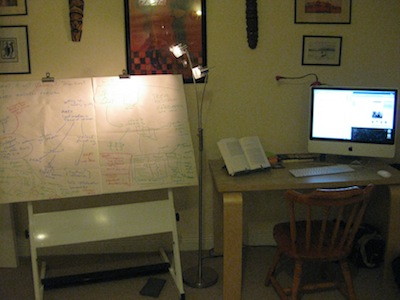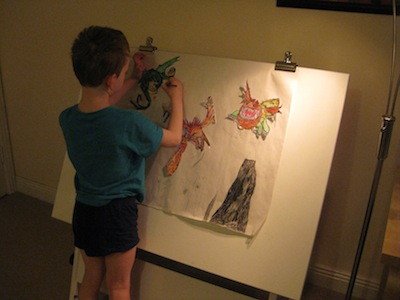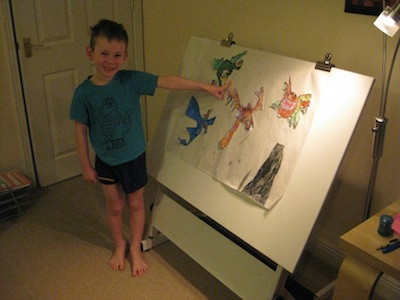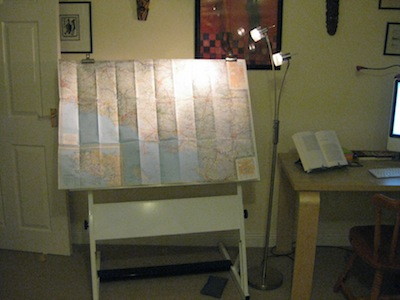All 31 entries tagged Inspiration
Quotes and media gathered from many sources as part of my research, development and design activities. Use these resources to inspire alternative perspectives on existing problems, or as a starting point in understanding unfamiliar situations.
View all 49 entries tagged Inspiration on Warwick Blogs | View entries tagged Inspiration at Technorati | There are no images tagged Inspiration on this blog
February 01, 2011
About my design studio, and my new drawing/design board.
I've recently replaced one of my flat tables with an A1 adjustable drawing/design board. It's great, for my design work and for my research. I have A1 sheets that I can clip to it, and lots of post-it notes. Having such a big canvas to work on makes a great difference to my work. When I finish working on something, I can un-clip it and pack it away. It's height and angle adjustable, so I can work standing or sitting. It even folds completely flat, so can be used as a height adjustable table (ideal for doing stop-motion animation).
Here's a photo of the board and the rest of my studio set up (with an iMac):

Of course it has also been colonised by Lorenzo. He has designed scientific experiments on it, written storyboards, and created diagrams:


It's also useful for planning expeditions:

January 31, 2011
Mantle of the designer? John O'Toole and Julie Dunn on process drama and technology
A review of: O'Toole, John & Dunn, Julie "Learning in Dramatic and Virtual Worlds: What Do Students Say About Complementary and Future Directions?", Journal of Aesthetic Education, Vol. 42, No. 4, Winter 2008.
The title of the paper under consideration indicates a coming together of two spheres:
- drama based education - the "process drama" approach as described in Pretending to Learn (O'Toole & Dunn, 2002), a pedagogical approach (that can be used in all subjects);
- "virtual worlds" - with a wider scope than just immersive game-like environments, including ICT that brings different places, times and realities into the classroom (or perhaps, takes the classroom out into different worlds) and into the minds and hands of the learners and teachers.
It is written just as new technologies are emerging that promise to extend and transform what is possible in drama and the classroom. As such it marks a significant engagement and perhaps a subtle attempt to steer the direction of development. One might assume a good fit between the two. The aim of process drama is for the learner to develop deeper, multi-perspectival, sophisticated understandings of issues, places, people and events, with a genuine sense of engagement, through first-hand (dramatised) experience. Many newly available technologies have the potential to enable behaviours that support these aims: rapid prototyping, experimentation, immersion, varying granularity of perception (zooming in and out on a situation or its timeline), rewinding and altering causal-chains, recording (for later reflection), and the combination of many different view-points and locations into a single observational “panel”. As part of the Open-space Learning in Real World Contexts project at the University of Warwick, we have let our imaginations run a little wild in creating design concepts that use these techniques (documented in the OSL Observatory). However, we should be cautious. I argue, and I think the paper supports this point, that there is a radical difference in the design-values behind new technologies and the values of process drama and more ge nerally, creative education.
The article reports on an exercise in participatory action research/ design with an emphasis upon the voice of the learner, and the learner as designer. Perhaps this is Heathcote's "mantle of the expert” pedagogical pattern, in which learners take on the role of experts, adapted into a "mantle of the designer" pattern. The workshops under consideration handed over to the students an exciting responsibility: designing a virtual and interactive learning experience (teaching about the climbing of Mount Everest). The subject matter was deliberately problematic and further problematised during the session, being within "the History's Purchased Page process drama unit" (p.92). Questions concerning the authorship and reliability of historical accounts, "knowledge as problematic" (p.93), were carefully introduced into the scenario as a challenging dilemma that:
“…incorporates conflict, but in a layered, complex form that problematizes the relationships of the participants to each other and to the fictional context.” (p.96)
As the authors state, the purpose of the research was to discover:
"What do young learners say about how they experience and value learning in a context involving a combination of drama and computers?"
"What ideas do these young learners have about how future technologies might enrich the complemenarity of this combination?" (p.90)
To assist in their independent response to the design challenge, the students were supported by a professional interaction designer from the Australasian Collaborative Research Centre for Interaction Design (ACID).
The opportunity to test the methodology (students as learning/computer designers) was a significant collateral benefit. Experimenting with new uses of technologies and techniques for discovering/thinking/creating/designing added a fourth significant objective. This included opportunities to consider how commonly encountered design patterns for virtual experiences (video games, Second Life) fall short of those required for process drama work:
"...from our perspective as drama educators, we believe that there are considerable gaps and limitations in the way these games use the key elements of drama." (p.94)
They argue that:
"...the gamesmaster has no control over the level of engagement (or immersion) during the game, nor what emotional disturbances or residues the participant may be left with after leaving...By contrast, the teacher/facilitator is constantly monitoring engagement, through reading verbal and nonverbal responses of the participants, and can modify the depth of experience, the level of empathy, and the emotional distance from the dramatic roles and situation." (p.95)
Control over distance is, they say, essential:
"distance of the character from the center of the emotional event" and "distance through techniques of deliberate artifice" (p.95).
In this particular case, the use of dramatic-pedagogical techniques allowed for this subtle and sensitive control, also extending into a careful use of "dramatic tension" (p.96) employed to "drive drama and sustain the participants' motivation in their roles as characters in the fictional contexts" (p.96). This amounted to an immersive and challenging experience, dependent upon the rich workings of "not just cognitive but also sensory, emotional, kinaesthetic, and, above all, social" forces to create "knowledge that is transformative, usable and transferable" (p.97).
What was the role of technology in this successful learning experience? The authors state that:
"a deftly placed visit to the Internet can throw a completely new challenge into the drama." (p.91)
Which it did, throwing new challenges concerning the truth of historical narratives into the pot. As such it acts as a disrupter and an inspirer. Materials brought into the drama from outside were then used as elements in the process of building to think, to design and to act. Perhaps as technology advances, it will be possible to make more constructive use of images, sound and other sensory inputs, used by the learners to build narratives and experiences, to test ideas and to challenge themselves: not just to increase the number of facts present (there was divided opinion from the students as to whether this is good or bad); but also to aid with visualisation and immersion (the students highlighted this as being important). For example, “tablet” style devices (Apple iPad) allow students to bring sound, images (still and moving), text and even remote actors into the learning space in a way that is easily manipulated and displayed. When interviewed about the learning experience, the students clearly valued the ability to make the experience more real – “a sense of verisimilitude” (p.98); but the students would like it to be even more real:
“Some of the students would have liked a more sensory experience, with a number suggesting that future developers of interactive environments should consider including opportunities to engage the senses of hearing and touch.” (p.99)
When analysing the students’ responses, the authors created two lists: aspects of the dramatic experience that the students valued, and aspects of the computer experience that they valued. Taken togeth er, these positive responses indicate the effectiveness of the pedagogical techniques, and the design challenge given to the students. The learners were well engaged and motivated through a well visualised context and personae, encouraging active participation, social interaction, decision making, leading to a deeper understanding of the historical problem and the problems of knowledge (p.97-98). What then did technology add to this? The obvious benefits were highlighted: verisimilitude and the opportunity to access information. As often is the case, access to computers and the internet increased motivation (although we may over time find that this effect wears off). Significantly, the students identified “socialization” as a key benefit. How does the addition of technology improve social interaction? I can think of some common reasons. Perhaps by providing an object for group interaction and sharing of skills? Perhaps it allows a degree of specialisation to occur with groups of learners (with some taking the role of tech-specialist)? Perhaps, within the context of a design challenge and students as designers, technology provides additional affordances, constraints and enabling constraints to be manipulated socially? – affordances and constraints that link together the social thinking of the group with vast complexities of reality beyond the classroom. I think this is the most interesting possibility, the most powerful potential benefit that new technologies can bring to the classroom and the drama. As I think the article indicates, we are starting to see these effects, but the technology is not quite there yet, not quite right. Will it ever be? Not inherently. Technology developers have no reason to be interested in selling products that challenge consumers, that promote social contention of the kind found in process drama. Perhaps the key then is for teachers and learners to become more adept at taking, adapting and using technologies for these ends – to become more design minded and less naïve in their acceptance of technologies – to take on the “mantle of the designer”. Not “designer” in the sense of Versace, but rather the more important role of designer as the creator/discoverer of the contentions and [dis]solutions necessary for genuine innovation – as described by Bruno Latour in his seminal lecture “A Cautious Prometheus?” (2008).
O’Toole and Dunn’s research is a good step towards this aim.
_____________________
Latour, Bruno A Cautious Prometheus? A Few Steps Toward a Philosophy of Design, Keynote lecture given to the History of Design Society, Falmouth, 2008 - available online at http://www.bruno-latour.fr/articles/article/112-DESIGN-CORNWALL.pdf[accessed 14th November 2010] >
O'Toole, John & Dunn, Julie "Learning in Dramatic and Virtual Worlds: What Do Students Say About Complementary and Future Directions?", Journal of Aesthetic Education, Vol. 42, No. 4, Winter 2008.
November 11, 2010
Lyotard on why poetry and art matters
Just a I finished writing my essay about how my research is finding designerly value in arts and humanities education, I was randomly reminded of Jean-Francois Lyotard's brilliant "download your brain onto a hard drive and blast it into space" fable. I'll use this at the start of my thesis:
"One of the characteristics of the open systems the fable calls “liberal democratic” is to leave open certain spaces of uncertainty that are apt to facilitate the appearance of more complex organizations, and this, in every realm. What we call research is a case, become trivial, of these spaces freed for invention and discovery. The case is itself the sign of a superior development, where necessity and chance are combined not only in the epistemological order, as Monod saw, but in the reality of a new alliance, in the terms of Prigogene and Isabelle Stengers. The alliance is not that of the objective with the subjective, but that of rule and chance, or of consecution and discontinuity." (Lyotard, Postmodern Fables, 1999: 94)
The idea of using Jacques Monod's Chance and Necessity (on autopoiesis in chemical and biological systems) with Prigogene and Stengers' Order Out of Chaos (the physics of self-organising systems), is irresistable.
 Robert O'Toole
Robert O'Toole

 Please wait - comments are loading
Please wait - comments are loading





